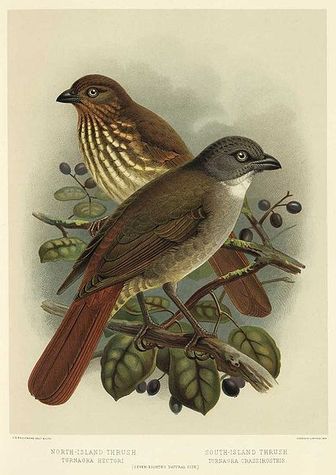New Zealand Thrush
Two subspecies are recognized, the nominate T. c. capensis from the South Island mainland, and the much smaller Stephens Island Piopio from Stephens Island, which is often considered to be based on juvenile birds, but seems to be valid . The assumption of the well-flying bird evolving into a distinct subspecies on the small island close to the mainland seems hard to believe, but Stephens Island must have held a population of many hundred birds in 1894 , and the Piopio was apparently a reluctant flyer, not usually being found on offshore islands.

Original source: By J. G. Keulemans, in W.L. Buller's A History of the Birds of New Zealand. 2nd edition. Published 1888.Permission(Reusing this file) This file is licensed under the Creative Commons Attribution-Share Alike 3.0 New Zealand license.You are free:to share – to copy, distribute and transmit the work
Author: By J. G. Keulemans, in W.L. Buller's A History of the Birds of New Zealand. 2nd edition. Published 1888.Permission(Reusing this file) This file is licensed under the Creative Commons Attribution-Share Alike 3.0 New Zealand license.You are free:to share – to copy, distribute and transmit the work
The New Zealand Thrush is classified as Extinct (EX), there is no reasonable doubt that the last individual has died.
the Piopio, or New Zealand Thrush, the subject of the present article, and unquestionably the best of our native songsters. His song consists of five distinct bars, each of which is repeated six or seven times in succession; but he often stops abruptly in his overture to introduce a variety of other notes, one of which is a peculiar rattling sound, accompanied by the spreading of the tail, and apparently expressive of ecstasy. More
NEW ZEALAND THRUSH (Piopio) Turnagra capensis Size: 27cm. Status: Very rare, possibly extinct. Range: Uncertain. Habitat: Native forest. Food: Fruits, seeds, foliage and insects. Voice: A short, sharp, whistling cry, quickly repeated, pio-pio. Alarm call is a loud pek-pek-pek-pek, resembling a bellbirds, but slower, louder and harsher. Breeding: Little available information. Two eggs, white or pinkish white with scattered black or brown spots. More
Piopio or New Zealand Thrush Turnagra capensis capensis (Sparrman, 1787) * RMNH 110.040: September 1873. * RMNH 110.041: male. Big bay, Southern Island, New Zealand. Collector: H. Suter, 16 October 1905. * RMNH 110.056: New Zealand. Bought from: Frank, 1876. * RMNH 110.057: adult, female. Southern Island, New Zealand. Aqcuired: 1846. * RMNH 110.058: juvenile, female. Southern Island, New Zealand. More
Piopio or New Zealand Thrush Turnagra capensis turnagra (Schlegel, 1865) * RMNH 89869: adult. Northern Island, New Zealand, 1846. Aqcuired: 1870. Holotype, Otagon tanagra Schlegel, 1865. * RMNH 110.054: female. Northern Island, New Zealand, 1871. * RMNH 110.055: female. Northern Island, New Zealand, 1870. Inappropriate name Neither the English nor the scientific name of the Piopio is appropriate. The bird is often referred to as the New Zealand Thrush. More
* South Island Piopio or New Zealand Thrush, Turnagra capensis * Stephens Island Piopio, Turnagra capensis minor * North Island Piopio, Turnagra tanagra References - 1. ^ IOC World Bird List Vol. 2 2. ^ a b Worthy, Trevor H.; Richard N. Holdaway (2002). The Lost World of the Moa. Bloomington: Indiana University Press. pp. 424–427. ISBN 0-253-34034-9. More
Piopio, the New Zealand Thrush (Turnagra capensis) is unfortunately now extinct. This omnivorous, medium sized perching bird had a plumage of olive brown, rufous, yellow and yellowish-white. Its bill and feet were dark brown. It was about the same size as the New Zealand Tui (Prosthemadera novaeseelandiae). The European name is misleading since its resemblance to the Song Thrush (Turdus philomelos) seems coincidental. More
laughing owl, the New Zealand thrush, several species of wrens, three frog species, one bat species, at least 12 invertebrates such as snails and insects, the world’s largest ever gecko and the New Zealand trout. The most recent extinction was the South Island kokako, last seen in the 1980s. More
Family : Turnagridae
Genus : Turnagra
Species : capensis
Authority : (Sparrman, 1787)
